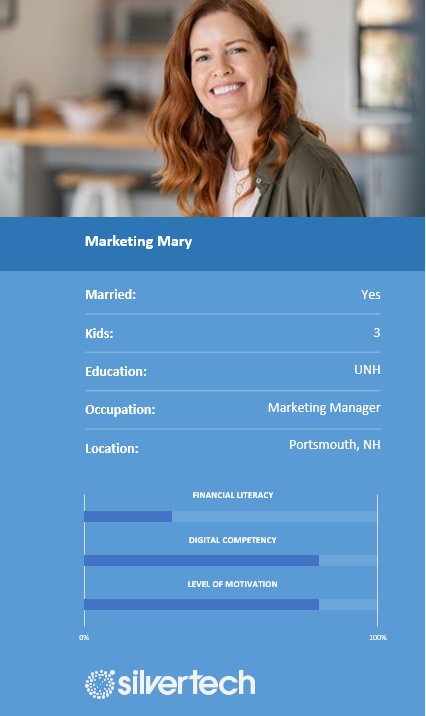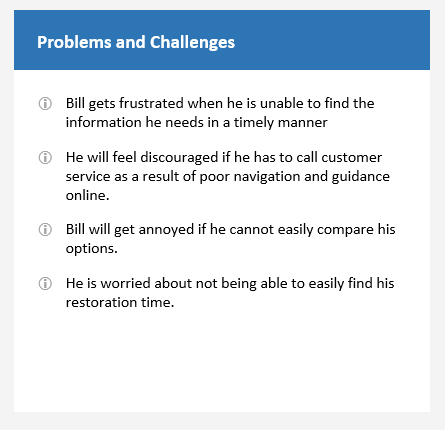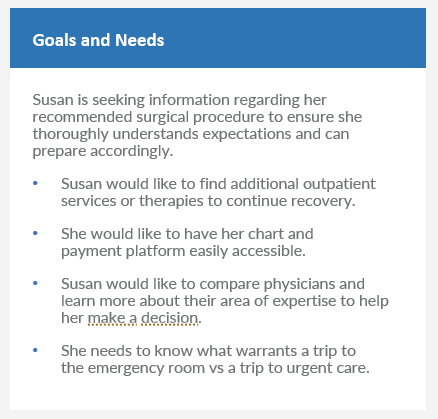The Importance of Identifying Key Personas
By: Morgan Withee | 7/18/22
What is a persona?
The User Experience definition means creating a fictitious character representing a segment of customers to allow a company to focus its efforts on catering the experience to those audiences. Personas should be based on user research but can also involve some storytelling: it’s an “activity of empathetic role-play.” (The Inmates are Running the Asylum - Alan Cooper.)
Say you’re running a campaign for a new assisted living home. You probably wouldn’t push advertisements to 15-year-olds. You’d want to push those ads to users who might be looking for that kind of information. Not necessarily the one who needs assisted living, considering they probably don’t spend as much time on the internet or social media to see these advertisements. Therefore, your target audience would likely be users in their 40s to 60s whose parents might be at or nearing the age where an assisted living situation is becoming a necessity. Now that you’ve determined the target audience, this will inform decisions on messaging and imagery. See how we got here?

A persona might include information such as:
- Name - We create personas with names that help us quickly identify their stories, such as Money Planning Matt, Student Debt Sandra, Retirement Rob, etc.
- Demographics - Information in this area could include anything deemed applicable, such as age, occupation, location, salary, home life, etc.
- Financial Literacy - This metric helps us visually see how large a financial knowledge gap this group of users might have.
- Digital Competency - A user’s level of digital competency might speak to their comfort level with engaging digitally, i.e., Scheduling an appointment online vs. calling on the phone.
- Level of Motivation - This ability metric helps us understand if there is a sense of urgency users will feel to engage with you digitally and whether they are likely to act soon.
- Segment or Group - Groups could include prospective employees, current employees, new customers, current customers, etc.
- Bio - Having a back story for your persona helps further support specific requirements or functionality required to meet their needs or expectations.
- Software and Applications - Any platform this user group is primarily using, i.e., Twitter, Instagram, YouTube, Venmo, etc. It can play a role in determining where to run advertisements or what software they are primarily using for you to consider when developing a website or application. We also use this as a baseline of expectations the user may have regarding the experience. For instance, if they are used to scrolling on Facebook, they may be more likely to scroll deeper on your website page.
- Problems and Challenges - This section details the frustrations a user faces while trying to perform a specific task or an issue they are having that we could potentially solve with the website.
- Goals and Needs - This details the ideal experience and includes tasks this persona would like to perform. However, it doesn’t stop at the website. There are opportunities to delight through other digital tools – i.e., CRM, email campaigns, apps, etc. The Ideal Experience is meant to be an “ideal” that we can work toward over time in all efforts.


Why is it essential for my business to develop personas?
We are all guilty of thinking everyone knows what we know. Personas help to remind us that not everyone does. It also reminds us that people ultimately care most about their own problems. So, we should be focused on solving their problems, not selling our products. Customers first.
Without personas, you may miss critical pieces of information or functionality that a user may be expecting to find on the website. This could ultimately cause them enough frustration to leave your website and search elsewhere for the information. It’s important to know who your audience is, so you know whom you’re trying to speak to, i.e., if you’re targeting small businesses vs. large corporations, your language and imagery might resonate with one group over the other.
We cannot deliver anything effectively without first understanding the audience. That is what makes personas key. Ultimately, they should be a cornerstone document from which all your marketing efforts stem.
How do personas influence web design and strategy?
After identifying the motivations and frustrations that lead us to the ideal experience, we’ve answered a lot of content and UX-related questions. At this stage of the persona exercise, the Ideal Experience section of the document stands to “fix” the problems found in the Frustrations & Barriers section. We use personas to identify key features or functionality needs that a user may expect to see on the website, or a specific page type, etc., as well as any content areas required, whether it be directional content, a callout to a critical section, the need for a more obvious login box, etc.
Website design and strategy (UI and UX) heavily rely on personas to determine the best path forward for the website’s layout and information architecture. Using best practices and design patterns alongside personas provides a more straightforward understanding of where essential elements should go on your website to ultimately end up with a seamless user experience.
It’s also essential to update personas every year. Considering how fast technology moves, preferences typically change along with it. Not only that, but a lot can also change in a year. Look at what happened in 2020. It’s important to pivot and incorporate relevant information that addresses a user’s needs in the current climate.
For more information about Personas or any marketing-related questions, reach out to us! We’d love to hear from you. No gimmicks or sales pitches; we are always available for a free consultation – no strings attached!
Categories:
UX Strategy & Design

